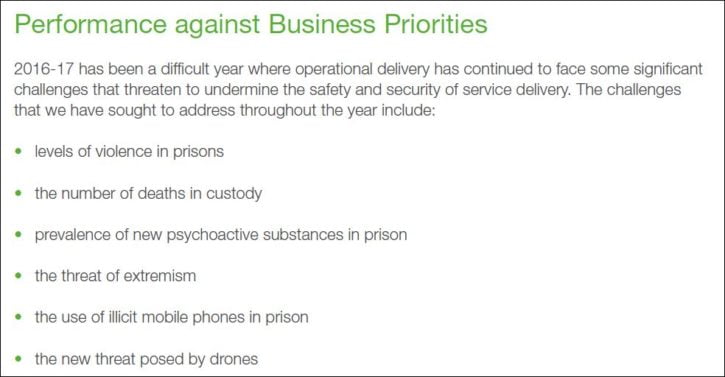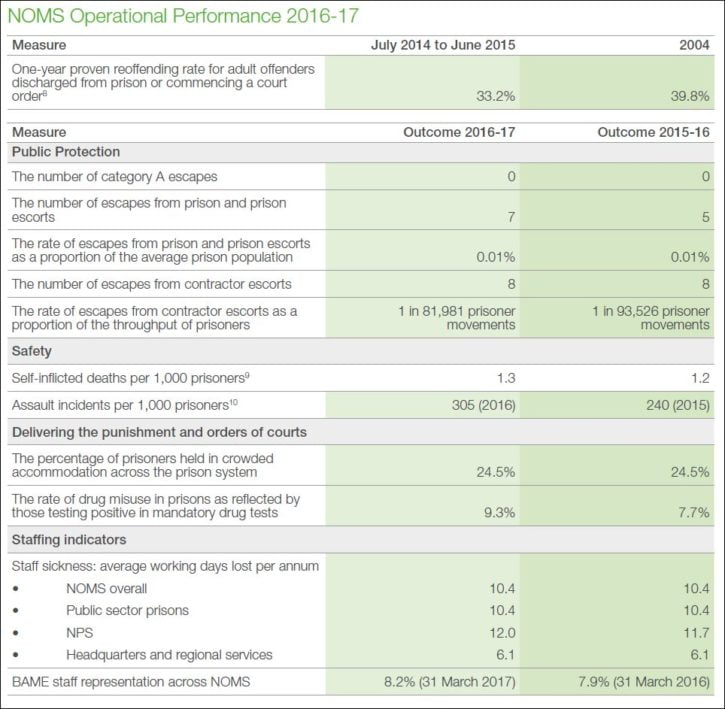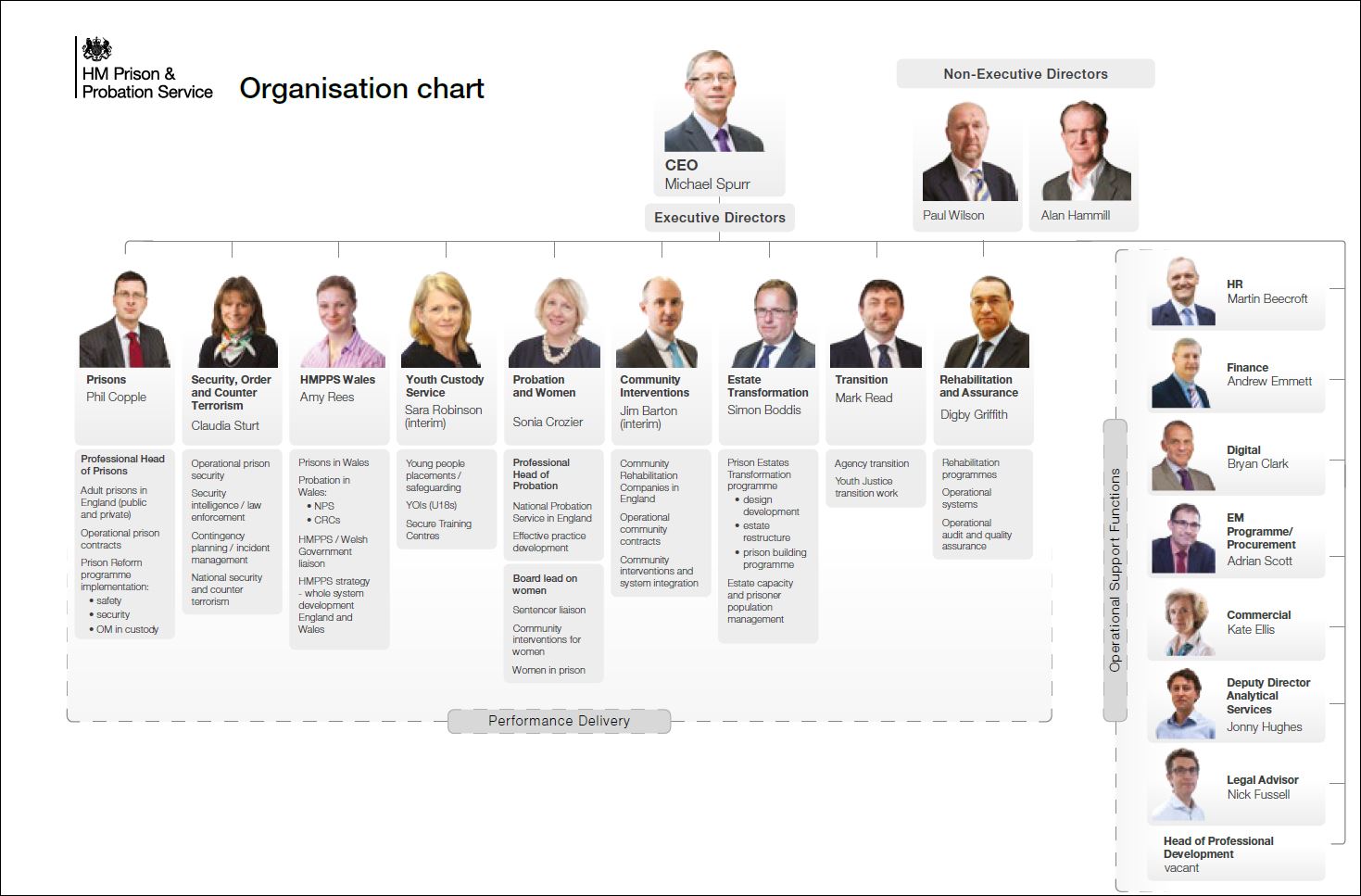RIP NOMS
The National Offender Management Service (NOMS) has just (19 July 2017) published its final Annual Report and Accounts. Next year’s report will be under its new name — Her Majesty’s Prison & Probation Service.
This blog post sets out 10 things that I found of interest in the report — I hope you do too.
1: NOMS remains almost entirely prisons-focused
Despite being responsible for prisons and probation, NOMS has always been notoriously prisons-focused (you may detect the chip on my ex-probation shoulder). This is confirmed by the start of this year’s report which highlights six challenges which have faced NOMS in 2016/17. You would think the general poor performance of post-TR probation might have featured, given the under-performance of many National Probation Service divisions as well as their Community Rehabilitation Companies counterparts (NOMS/HMPPS is only responsible for CRCs in a contract manager role). But no:

2: The Offender Management in Custody model
Here’s NOMS description of the model which is integral to the prison reform project:
The model will increase the number of prison staff while providing them with more time for meaningful face to face contact with prisoners. Governors will have the freedom to determine the mix of grades of staff to best meet the needs of their population.
There are five key principles:
- that the resources available should be targeted to offender groups proportional to the risks and needs presented and duplication is removed – in particular reducing the number of assessments.
- for offender management to be effective and for prisons to be positive places in which to work there must be a strong rehabilitative culture across all activity within prisons.
- relationships between offenders and staff must be developed further. They should be supportive, yet challenging – offering hope, encouragement and empowering offenders to take responsibility for their lives and their futures. Prison officers will have a key role in this.
- for good quality offender management practice to be consistently delivered we need the right staff, those who are appropriately trained, skilled and motivated. We need to invest in training and supporting all staff involved in offender management.
- governors will be responsible and accountable for the quality of offender management delivered in their prison.
3: Probation Recruitment
750 probation officers qualified during 2016-17. 150 trainee probation officers were recruited during 2016-17, with an additional 400 planned up to December 2017.
4: Polygraphs for high risk sex offenders
The mandatory polygraph testing of high risk sex offenders released from custody on licence is firmly established as a key tool in the management of this group of offenders. Referral figures have steadily grown and the number of tests completed is 82% higher in comparison to year one of the project which commenced in August 2014.
5: Digital investigations
NOMS has established a dedicated digital investigations unit to enable quicker identification of any offender committing a potential criminal offence by posting inappropriate content on social media sites, and says it has significantly improved relationships with social media companies to enable the swift removal of that content.

6: £1.3 billion prison building programme
The main features of the Prison Estate Transformation Programme (PETP) are:
- build up to 10,000 new prison places with better education facilities and other rehabilitative services;
- reorganise and simplify the prison estate into three key functions: reception, training and resettlement – this will improve safety, make sure prisoners are held in environments that match their needs and risk and have access to appropriate services; and
- build five Community Prisons for Women (CPWs) which will replace existing provision and consist of 60 beds each and hold lower risk female prisoners.
7: Smoke free prisons
At the end of the financial year, there were 21 smoke free prisons with the whole estate scheduled to be smoke free in 2018.
8: Women in the community
NOMS has a policy to reduce the numbers of women being sentenced to short custodial sentences by developing robust community sentences which are specifically tailored to the needs and risks of individual women. It has piloted a SMART tool to ensure Pre-Sentence Report authors consider the full range of community requirements when proposing a community sentence for women in the hope that there will be more proposals for treatment, residence and curfew requirements which the court may consider as realistic alternatives to short custodial sentences.
9: Women in custody
NOMS is working on six “work-strands” to improve the service delivered to women in prison:
- Health and well-being
- A trauma-informed rehabilitative culture
- Decency (appropriate clothing and a more gender appropriate and sensitive environment)
- Links with children and families
- Transitions (supporting women at transition points into and through the system to help address self-harm and suicide)
- Domestic abuse

10: Education
The MoJ/NOMS/HMPPS took over responsibility for prison education for adults from the Department for Education in October 2016. The annual report sets out five priorities in this area:
- make prison governors fully responsible for education provision in their prisons, commissioning the services they think are most appropriate in their individual prison.
- bring more employers into prisons to provide training and real work experience across the regime.
- provide professional development for all grades of staff, including governors, to help them deliver high quality education and developing a scheme to attract high calibre graduates to work in prisons.
- develop a set of education performance measures for all prisons.
- ensure that those providing education in prisons have the right skills and capabilities.
All prison posts are kindly sponsored by Prison Consultants Limited who offer a complete service from arrest to release for anyone facing prison and their family. Prison Consultants have no editorial influence on the contents of this site.









One Response
Noms was a waste of time and money, a detriment to probation and the prison service. Nothing will change with HMPPS just the name